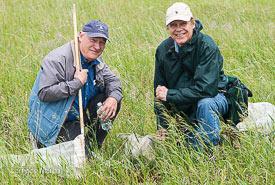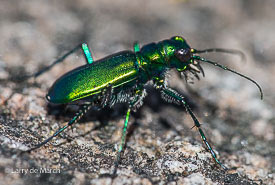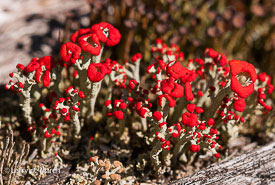Buzzword biodiversity

L to R: Terry Galloway and Bob Wrigley (Photo by Larry de March)
Biodiversity is a relatively new word in the conservation arena. Broadly defined, the term refers to the number of species in, or biological richness of, an area. In spite of biological inventories and diverse studies carried out over centuries throughout much of the planet, our knowledge of the natural world remains in its infancy — particular in distant and hazardous locations (e.g., sea floor).
As biologists working in such facilities as museums, universities, provincial/territorial wildlife departments, zoos, aquariums and conservation organizations, we tend to believe we have a reasonable grasp of the biodiversity in our area or province. But do we really? Could we list the taxa in our district, or even on the properties where we live and work?
We generally know what the larger and easily observed species of wildlife are, or the species in our areas of specialty, but this is just the tip of an enormous wealth of life forms of which we know literally nothing, with most species not yet even named and described. This is a serious omission in our knowledge base if we are truly to protect our local biodiversity, ecosystems, environment and specific habitats.
When we attempt to modify species’ populations, distributions (e.g., using exotics for biological control), habitats and even genes to support a species at risk or one of special interest (e.g., crops, commercial resource harvesting or recreational hunting/fishing), have we any idea what resulting waves (e.g., effects on numbers and gene frequencies of other biota) reverberate through the entire ecosystem? Yet at this time of greatest need for data, taxonomists and ecologists are declining in numbers due to lack of training and job opportunities (linked to funding priorities).

Laurentian tiger beetle (Cicindela sexguttata denikei) (Photo by Larry de March)
These dilemmas set me to thinking about what I could contribute to the biodiversity knowledge of my home province, Manitoba. And so I have, with all naivety and modesty, attempted the impossible — a first crack at a biodiversity inventory of this province. I greatly appreciate the contributions to this effort of my colleagues, whom I placed in the uncomfortable and challenging position of coming up with their best estimates. Hopefully others will be encouraged to generate or update inventories in their districts, and to enlarge their concept of local biodiversity and conservation requirements.
Manitoba hosts five major life zones or biomes:
- Grassland
- Boreal Coniferous Forest
- Arctic Tundra
- Freshwater
- Arctic Marine
Transitional zones include:
- Aspen Parkland
- Eastern Deciduous Forest
- Forest-Tundra
Each of these major biological communities teems with countless numbers of diverse species; from huge whales, lion’s mane jellyfish and the seven-metre greenland shark in Hudson's Bay, to bizarre microscopic life forms in the soil, water and air, and even in and on our bodies. Manitoba is truly buzzing with life during all seasons, even under the snow and ice.

British soldier lichen (Cladonia cristatella), Riding Mountain National Park (Photo by Larry de March)
Glaciers completely scoured the entire province of life about a dozen times in the last 1.5 million years — the Pleistocene Ice Age, which ended only 8,000 years ago. Yet Manitoba currently harbours all five kingdoms of life (plus viruses): bacteria, protoctista (microscopic protozoans and types of algae), fungi, plants and animals.
The larger types of animals and plants have received considerable attention and are more readily studied, so their numbers are reasonably well known. However, species estimates for most other groups are only recently becoming available.
Manitoba's plant and animal life includes:
- 635 vertebrate (back-boned) animal species (88 mammals, 391 birds, 8 reptiles, 16 amphibians, 132 freshwater and marine fish)
- over 31,000 invertebrate species (“lower” animals)
- 2,433 plant species
- 800 lichen species (a symbiotic association of fungi and algae)
- 3,000 fungi species, and
- a staggering 36,000 algae species
Some of these figures will continue to rise with new studies. There are no numerical estimates for other groups, such as protozoans, bacteria or viruses (the latter two are capable of rapid genetic change), but they exist in Manitoba in the tens or hundreds of thousands of species or types. While mostly unknown, they form the supporting base of complex food webs, are integral to the cycling of matter and energy, and maintain conditions for life on our Earth.
The diversity of life in Manitoba is always changing over time, both in the short term and over the geological time frame. This occurs due to many factors in nature, such as varying climate, sea level, species distribution, relationships with other species and even bolide-impact events (i.e., meteorite, asteroid, comet). While earlier times (e.g., 10,000 years ago) witnessed the extinction of dozens of large mammals and birds in our region, only 10 species are officially (CDC Nature Serve) recognized as having been lost from Manitoba during historic times, either from extinction, like the passenger pigeon and Rocky Mountain locust, or extirpation (i.e., survives elsewhere) such as the swift fox and whooping crane. An additional 25 species have not been detected for several decades and may be extirpated, while many other invertebrates have likely disappeared with the loss of native grassland.
To date, 1.75 million species have been named worldwide, and likely over 100 million species (mostly insects and microscopic forms) await discovery. Yet this is but a tiny fraction of the incredible biodiversity (countless billions) that has evolved over the last 3.6 billion years of life on Earth.
So how many species are alive now in Manitoba? No one will ever be able to answer this question, but the number may exceed half-a-million. Each property conserved by NCC no doubt harbours tens of thousands of species, when microscopic life is included. This rich biodiversity interacts within the various ecosystems of our province, generates our life-support systems, and supports our economy and standard of living. On the local level and worldwide, it is to our great advantage to support the conservation of all wildlife and to protect our environment.
References
Hamel, Cary (pers. comm.) Nature Conservancy of Canada, Manitoba Region, and the Manitoba Conservation Data Centre.
Stewart, DB, and W.L. Lockhart, 2005, An overview of the Hudson Bay Marine Ecosystem, Can. Fish. Aquat. Sci. 2586. A remarkable inventory of the little-studied ecosystems of Hudson Bay.
Wrigley, R.E. 2007. Zoological Author and Editor, The Encyclopedia of Manitoba. Great Plains Publications, 814 pp. The most-current and comprehensive information on Manitoba biodiversity.
By Dr. Robert E. Wrigley, NCC Manitoba Board member and Chair of the Scientific Advisory Network
This article was first published in NatureNorth.com.


